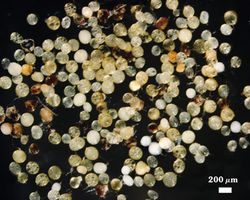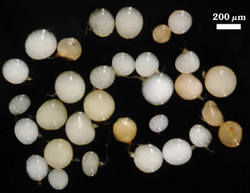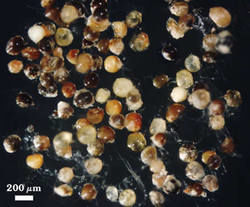Scutellospora calospora
Preparing Clean Healthy Spores for Shipment

Extracted Spores
Spores of this species are pale greenish-yellow, so any with darker pigments are immediately suspect as being unhealthy or dead. These “deviants” are readily detected and can be culled from the population without much effort.
Immature Spores

The most prominent visual clue of immature spores is the uniformly dense and opaque contents. Color of these contents will vary from bright white to pinkish salmon. Spores that are collapsed or contain patchily distributed contents are considered nonviable and not likely to develop further. Immature spores are not infective because germinal inner walls necessary for germination shield formation have yet to form.

Degraded or Parasitized Spores
Spores are quite dead if contents are not clear, and examples of this are abundant in the photo above. Spores with hyphae emerging from them are clearly parasitized. Spores with irregular shapes (dimples) combined with patchy contents suggest degradation or senescence.
Darker Spores

Depending on host, soil type, greenhouse conditions, and who-knows-what other variables, a high proportion of newly formed spores may be darker or lighter (usually the former) than typical. Spore contents, in the photo above, are mostly normal, with only a little more fusion of lipid globules than expected. When used as inoculum, these spores are infective and show no evidence of being parasitized.

Healthy spores that have shown little change over at least 24 hr are considered ready for shipment in sterile sand. Notice that the spores in this photo have relatively uniform lipid globules. Any deviation from this, even if spores otherwise appear healthy, warrants removal. With darkly pigmented spores, it is better to err on the side of caution.